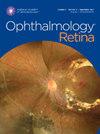Macular Atrophy-Related Observations in Eyes Treated with the Port Delivery System with Ranibizumab in the Archway Trial
IF 5.7
Q1 OPHTHALMOLOGY
引用次数: 0
Abstract
Purpose
To compare the development of macular atrophy (MA) in eyes treated with the Port Delivery System with ranibizumab (PDS) with those treated with monthly intravitreal ranibizumab injections in the Archway trial.
Design
Preplanned exploratory analysis of a phase III, open-label, randomized trial.
Participants
Patients with neovascular age-related macular degeneration (nAMD) diagnosed within 9 months of screening, previously treated with and responsive to anti-VEGF therapy.
Methods
Eyes were randomized 3:2 to treatment with the PDS 100 mg/ml with fixed 24-week (Q24W) refill-exchanges (PDS Q24W) or intravitreal ranibizumab 0.5 mg injections every 4 weeks (monthly ranibizumab).
Main Outcome Measures
Prevalence, incidence, and progression of MA.
Results
The analysis population consisted of 415 eyes (248 and 167 eyes in the PDS Q24W and monthly ranibizumab arms, respectively). At the study baseline, MA was observed in 22.3% (PDS Q24W) and 20.4% (monthly ranibizumab) of eyes. At week 96, the prevalence of MA was 39.1% and 39.2%, whereas the incidence of new MA in eyes without MA at baseline was 20.0% and 22.6% in the PDS Q24W and monthly ranibizumab arms, respectively. In eyes without baseline MA, the mean MA area at week 96 was 0.4 in the PDS Q24W arm and 3.8 mm2 in the monthly ranibizumab arm with a difference of 3.4 mm2, (P = 0.054) favoring the PDS. In eyes with baseline MA, the mean change in MA area from baseline to week 96 was +2.2 mm2 for both the PDS Q24W and monthly ranibizumab arms.
Conclusions
In the Archway trial, which compared PDS Q24W with monthly ranibizumab injections for nAMD treatment over 2 years, the prevalence and incidence of MA were similar between arms over the study duration. In eyes without baseline MA, PDS-treated eyes had less MA area by 3.4 mm2, a potentially clinically meaningful (although not statistically significant) difference. The results of this prespecified exploratory analysis suggest that PDS treatment is not associated with a higher incidence or progression of MA when compared with monthly injections of ranibizumab. In eyes without baseline MA, the progression of the atrophy area was 4 times less in PDS-treated eyes. Additional studies could further elucidate this observation.
Financial Disclosure(s)
Proprietary or commercial disclosure may be found in the Footnotes and Disclosures at the end of this article.
在Archway试验中,雷尼单抗Port给药系统治疗眼部黄斑萎缩的相关观察。
目的:比较Archway试验中使用Port给药系统联合雷尼单抗(PDS)治疗和每月使用雷尼单抗玻璃体内注射治疗的黄斑萎缩(MA)的发展情况。设计:预先计划的3期、开放标签、随机试验的探索性分析。参与者:筛查后9个月内诊断为新生血管性年龄相关性黄斑变性(nAMD)的患者,既往接受过抗血管内皮生长因子治疗并对其有反应。方法:以3:2随机分为两组:PDS 100 mg/mL联合24周(Q24W)固定补药(PDS Q24W)或每4周(每月一次)玻璃体内注射0.5 mg雷尼单抗。主要结局指标:MA的患病率、发病率和进展。结果:分析人群包括415只眼睛(PDS Q24W组248只,每月一次的雷尼单抗组167只)。在研究基线时,在22.3% (PDS Q24W)和20.4%(每月雷尼单抗)的眼睛中观察到MA。在第96周,MA的患病率为39.1%和39.2%,而在PDS Q24W组和每月一次的雷尼单抗组中,基线时无MA的眼睛的新MA发病率分别为20.0%和22.6%。在没有基线MA的眼睛中,96周时PDS Q24W组的平均MA面积为0.4,每月雷尼单抗组的平均MA面积为3.8 mm2,差异为3.4mm2, (P = 0.054)有利于PDS。在基线MA的眼睛中,PDS Q24W组和每月雷尼单抗组的MA面积从基线到第96周的平均变化为+2.2 mm2。结论:Archway试验将PDS Q24W与每月注射雷尼单抗治疗nAMD进行了为期2年的比较,在研究期间,两组MA的患病率和发病率相似。在没有基线MA的眼睛中,pds治疗的眼睛的MA面积减少了3.4 mm2,这是一个潜在的临床意义(尽管没有统计学意义)的差异。这项预先指定的探索性分析的结果表明,与每月注射雷尼单抗相比,PDS治疗与MA的更高发病率或进展无关。在没有基线MA的眼睛中,pds治疗的眼睛萎缩面积的进展减少了4倍。进一步的研究可以进一步阐明这一观察结果。
本文章由计算机程序翻译,如有差异,请以英文原文为准。
求助全文
约1分钟内获得全文
求助全文

 求助内容:
求助内容: 应助结果提醒方式:
应助结果提醒方式:


